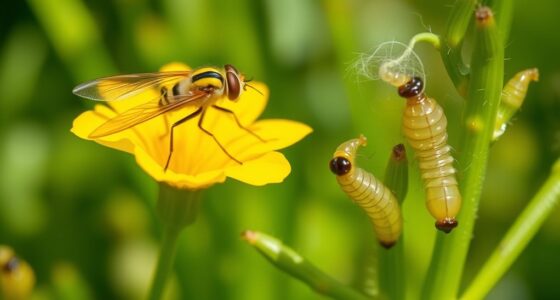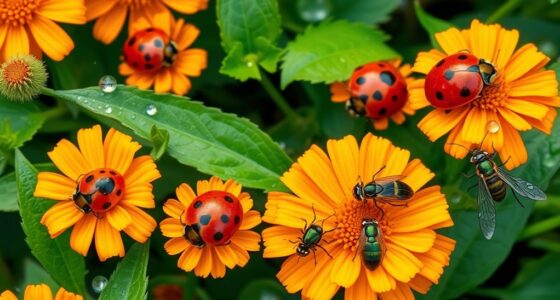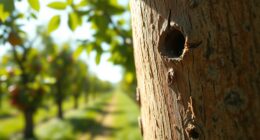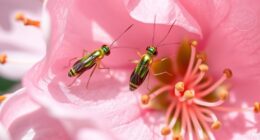To boost your garden’s health, focus on seven beneficial insects: ladybugs, which munch on aphids; parasitic wasps that target pest larvae; hoverflies that pollinate and feed on pests; bees, essential for pollination; ground beetles that hunt soil pests; predatory mites that control spider mites; and lacewings that eat aphids and caterpillars. Creating habitat and avoiding pesticides encourage these allies to thrive. Keep exploring to discover how each of these insects can transform your garden naturally.
Key Takeaways
- Ladybugs effectively control aphids and soft-bodied pests, promoting healthier plants.
- Parasitic wasps target pests like caterpillars and fly larvae discreetly and sustainably.
- Native bees, including bumblebees and solitary bees, enhance pollination and fruit production.
- Hoverflies feed on pests and assist in pollination, supporting garden health.
- Beneficial nematodes and ground beetles help manage soil-borne pests naturally.

Beneficial insects play a crucial role in maintaining a healthy garden by naturally controlling pests and promoting plant growth. When you introduce or attract these helpful creatures, you’re adopting pest control strategies that reduce your reliance on chemical pesticides, which can harm your plants and the environment. Instead, you create a balanced ecosystem where natural predators keep pest populations in check. Bees, ladybugs, and parasitic wasps are just a few examples of beneficial insects that can work wonders for your garden’s health. By encouraging their presence, you foster a system that actively manages pests while supporting pollination enhancement, which is essential for fruit and flower production.
Beneficial insects naturally control pests, promote growth, and support pollination for a healthier garden ecosystem.
Understanding how to attract and sustain beneficial insects requires some knowledge of their habits and preferred habitats. For example, planting a variety of native flowering plants provides nectar and pollen, essential food sources for many of these insects. This not only encourages their presence but also ensures they stay active throughout different seasons. You might consider incorporating flowering herbs like dill, fennel, or yarrow, which are particularly attractive to pollinators and predatory insects alike. Creating a diverse, pesticide-free environment ensures beneficial insects remain safe and effective in their pest control strategies. Additionally, maintaining a healthy soil environment supports the overall vitality of these insects, enabling them to thrive naturally.
Ladybugs are a gardener’s best allies when it comes to controlling aphids and other soft-bodied pests. You can purchase them commercially or encourage their natural migration by planting their favorite plants nearby. Once established, they’ll consume large quantities of pests, helping to keep your plants healthy without chemical interventions. Similarly, parasitic wasps target specific pests like caterpillars and fly larvae, helping you manage pest outbreaks discreetly and efficiently. These tiny wasps are harmless to humans and pets but deadly to pest insects, making them a sustainable pest control strategy.
Pollination enhancement is another critical benefit of beneficial insects. Bees, especially native species, are essential for pollinating fruits, vegetables, and flowering plants. When you create a welcoming environment for bees by planting a variety of flowers and avoiding pesticides, you boost your garden’s productivity. The increased pollination results in better fruit set, larger blooms, and overall healthier plants. Additionally, some beneficial insects, like certain beetles and hoverflies, contribute to pollination while also feeding on pests, offering a dual benefit to your garden ecosystem. Promoting these insects’ habitats with water sources and shelter also helps sustain their populations over time.
Incorporating beneficial insects into your gardening routine is a sustainable approach that supports healthy plant growth, reduces pest problems, and enhances pollination. By understanding their roles and creating inviting habitats, you’ll harness nature’s own pest control strategies and see your garden thrive naturally. Recognizing the importance of beach body health concepts like skin protection and UV safety can also extend to understanding how to protect beneficial insects from environmental stressors, ensuring a thriving and balanced garden ecosystem.
Frequently Asked Questions
How Can I Attract Beneficial Insects Naturally?
To attract beneficial insects naturally, you should focus on pesticide alternatives that avoid harming these helpful creatures. Create a welcoming habitat by planting a variety of flowering plants, herbs, and native plants to provide nectar and pollen. Leave some areas undisturbed with leaf litter or mulch to offer shelter. These steps encourage beneficial insects to thrive in your garden, naturally controlling pests and promoting healthy plant growth.
Are Beneficial Insects Safe for Pets and Children?
You might wonder if beneficial insects are safe for pets and children. Generally, these insects are non-toxic and pose minimal risk, making them safe for pet safety. However, some insects could cause mild reactions if ingested or handled roughly. Always identify the specific beneficial insects you’re encouraging, and avoid using pesticides that could increase insect toxicity. With proper management, beneficial insects can safely coexist with your family and pets.
What Is the Best Time to Introduce Beneficial Insects?
You should introduce beneficial insects when pest identification confirms their presence and before pests become a major problem. Timing is key—apply them early in the season or during pest outbreaks to maximize effectiveness. Guarantee insect habitat enhancement by providing diverse plants and shelter, which supports their survival. This approach helps maintain a healthy garden ecosystem, reduces chemical use, and encourages natural pest control, making your garden more resilient and productive.
Can Beneficial Insects Control All Garden Pests?
You might wonder if beneficial insects can control all garden pests, but they can’t do it alone. Pest resistance can develop, and some pests are simply too tough. To succeed, you need to combine beneficial insects with good insect habitat management, like planting diverse plants and providing shelter. This integrated approach guarantees more effective pest control, reducing reliance on chemicals and promoting a healthier garden ecosystem.
How Do I Differentiate Between Beneficial and Harmful Insects?
When differentiating beneficial from harmful insects, focus on pest identification and insect behavior. Beneficial insects usually have specific behaviors like rapid movement or targeted feeding, while harmful pests tend to stay on plants and cause visible damage. Observe their size, color, and movement patterns. If you’re unsure, consult a local extension or use identification apps. Recognizing these signs helps you protect your garden effectively by encouraging helpful insects and controlling pests.
Conclusion
By welcoming these seven beneficial insects into your garden, you’re summoning an unstoppable army of tiny warriors, ready to vanquish pests and transform your outdoor space into a lush, thriving paradise. Imagine a garden so protected, so bursting with life, that pests retreat in fear, and your plants grow taller than skyscrapers. With these insects on your side, you’ll wield the power to create the most vibrant, healthy oasis anyone has ever seen—no pest stands a chance!









